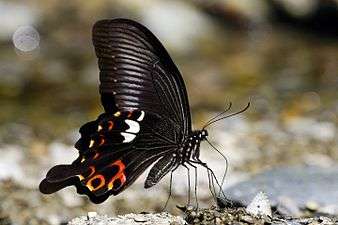Papilio helenus
| Red Helen | |
|---|---|
_at_Samsing%2C_Duars%2C_WB_W_IMG_6219.jpg) | |
 | |
| Scientific classification | |
| Kingdom: | Animalia |
| Phylum: | Arthropoda |
| Class: | Insecta |
| Order: | Lepidoptera |
| Family: | Papilionidae |
| Genus: | Papilio |
| Species: | P. helenus |
| Binomial name | |
| Papilio helenus Linnaeus, 1758 | |
Papilio helenus, the red Helen, is a large swallowtail butterfly found in forests of southern India and parts of Southeast Asia.
Range
Papilio helenus is found in Sri Lanka, southern and north-east India, Nepal, Bhutan, Bangladesh, Myanmar, Thailand, Laos, Kampuchea, Vietnam, southern China (including Hainan, Guangdong province), Taiwan, southern Japan, South Korea, Ryukyu Islands, peninsular and eastern Malaysia, Brunei, Philippines, and Indonesia (Sumatra, Java, Bangka, Kalimantan, the Lesser Sunda Islands except Tanimbar).
In India it occurs along the Western Ghats from Kerala to Gujarat, also Palnis and Shevaroys, in the north from Mussoorie eastwards, to north-east India and onto Myanmar.
Status
Papilio helenus is generally common and not threatened. It is commonly found from Kerala to Maharashtra, but rare in Gujarat. It is also found in abundance in north-east India, and very commonly sighted in Assam.[1]
Taxonomy

Species group
Papilio helenus is the nominate member of the helenus species group. The members of this clade are:
- Papilio helenus Linnaeus, 1758
- Papilio iswara White, 1842
- Papilio iswaroides Fruhstorfer, 1898
- Papilio nephelus Boisduval, 1836
- Papilio nubilus Staudinger, 1895
- Papilio sataspes C. & R. Felder, 1865
Subspecies
There are up to thirteen different subspecies, two of which occur in India:
- P. h. daksha Moore. South India. Not rare
- P. h. helenus Linnaeus. Mussoorie to Myanmar. Common
and one in Taiwan:
- P. h. fortunius Fruhstorfer, 1908.
Life cycle

This butterfly flies throughout the year in southern India.
Eggs
The egg is pale apricot-yellow in colour when freshly deposited, spherical in shape and has a slightly roughened exterior which looks like the skin of an orange when seen through a microscope. The diameter of an egg is 1.2 mm.
The eggs are deposited singly on the tips of very young leaves and shoots in shady parts of thick jungle. Before hatching, the eggs appear to be marked by chocolate coloured lines and flecks. The egg hatches in 4 to 7 days.
Caterpillar
The freshly emerged larva is about 3 mm long. Throughout the caterpillar stage, if it is agitated it can evert a yellow-to-red osmeterium from the first segment, just behind the head. Each of the other segments bears, on the back, a pair of tufts of stiff hairs, each tuft arising from a small, yellowish conical process. The overall colour is brown, but there is a whitish saddle-like patch about the middle and the tail segments are also whitish in colour.
Like other Papilio species the larva can evert a two-pronged horn-like osmeterium when it is irritated. The osmeterium secretes an repugnatorial|unpleasant-smelling liquid which is believed to repel predators and parasites.
After the first moult the caterpillar has the appearance of a shiny bird dropping. The larva is grass green in colour, mottled black and white and smoky grey. The osmeterium, when everted, is generally yellow to red.
While inactive, mainly during daylight hours, the young larva lies along the midrib of the underside of the leaf. Later on, when it is largely fully grown, it is greener and lies on the centre of the upperside of the leaf, on a stem or a twig. The fifth instar larva is about 5 cm long.
See also
References
- ↑ A Pictorial Guide Butterflies of Gorumara National Park (1st ed.). Jalpaiguri, West Bengal: Department of Forests Government of West Bengal. March 2013. p. 18.
- Collins, N. Mark; Morris, Michael G. (1985). Threatened Swallowtail Butterflies of the World: The IUCN Red Data Book. Gland & Cambridge: IUCN. ISBN 978-2-88032-603-6.
- Evans, W.H. (1932). The Identification of Indian Butterflies (2nd ed.). Mumbai, India: Bombay Natural History Society.
- Gay, Thomas; Kehimkar, Isaac David; Punetha, Jagdish Chandra (1992). Common Butterflies of India. Nature Guides. Bombay, India: World Wide Fund for Nature-India by Oxford University Press. ISBN 978-0195631647.
- Haribal, Meena (1992). The Butterflies of Sikkim Himalaya and Their Natural History. Gangtok, Sikkim, India: Sikkim Nature Conservation Foundation.
- Kunte, Krushnamegh (2000). Butterflies of Peninsular India. India, A Lifescape. Hyderabad, India: Universities Press. ISBN 978-8173713545.
- Wynter-Blyth, Mark Alexander (1957). Butterflies of the Indian Region. Bombay, India: Bombay Natural History Society. ISBN 978-8170192329.
External links
| Wikimedia Commons has media related to Papilio helenus. |
| Wikispecies has information related to: Papilio helenus |
